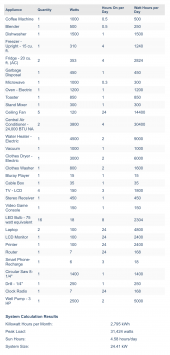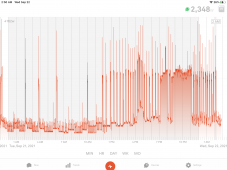dishmael
New Member
- Joined
- Aug 16, 2021
- Messages
- 4
We are at the very early stages of building a farmhouse on 20 acres in central Florida. There's grid access but we are hoping to only use grid power when necessary, relying solely on solar and batteries as much as possible. We will be utilizing a ground mount system since we have the space. We have a few initial estimates noted below for power needs. Based on my initial reading and the size of our system, I believe we are looking at using 48v for the system. Looking for any initial comments and suggestions on what we should be thinking about during this planning period. All help is greatly appreciated.
Goal: Off-Grid Whole House Power using PV and Batteries (if I can afford it)
Kilowatt Hours per Month: 2,795 kWh
Peak Load: 31,424 watts
Sun Hours: 4.58 hours/day
System Size: 24.41 kW (or should we over engineer with more solar?)
Given the cost of implementing the system to provide whole house coverage, I'm hoping to do this in stages.
Stage 1 (Grid Tied)
I'd like to implement a system that uses solar during the day and grid power at night. Is that possible? Are there inverters that will switch between PV and grid when the PV system is not generating enough power? This isn't an ideal end state as it does not protect against grid outages. I can always add a generator, which is likely cheaper than batteries - but I'm thinking that's more stage 2 expansion.
Stage 2 (Grid Tied with Battery Backup or Generator)
I'd like to augment the system with batteries to provide power at night and during cloudy weather. The system will continue to have access to the grid to prevent brownout from lack of energy, switching over to grid as necessary. Is this possible? Another option that may be cheaper is a generator. While I would prefer not to draw from grid at all, I do recognize the high cost of batteries. Perhaps we can use a generator as an in-between option.
Goal: Off-Grid Whole House Power using PV and Batteries (if I can afford it)
Kilowatt Hours per Month: 2,795 kWh
Peak Load: 31,424 watts
Sun Hours: 4.58 hours/day
System Size: 24.41 kW (or should we over engineer with more solar?)
Given the cost of implementing the system to provide whole house coverage, I'm hoping to do this in stages.
Stage 1 (Grid Tied)
I'd like to implement a system that uses solar during the day and grid power at night. Is that possible? Are there inverters that will switch between PV and grid when the PV system is not generating enough power? This isn't an ideal end state as it does not protect against grid outages. I can always add a generator, which is likely cheaper than batteries - but I'm thinking that's more stage 2 expansion.
Stage 2 (Grid Tied with Battery Backup or Generator)
I'd like to augment the system with batteries to provide power at night and during cloudy weather. The system will continue to have access to the grid to prevent brownout from lack of energy, switching over to grid as necessary. Is this possible? Another option that may be cheaper is a generator. While I would prefer not to draw from grid at all, I do recognize the high cost of batteries. Perhaps we can use a generator as an in-between option.






